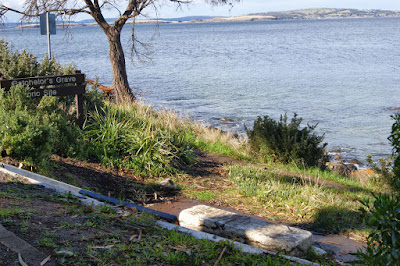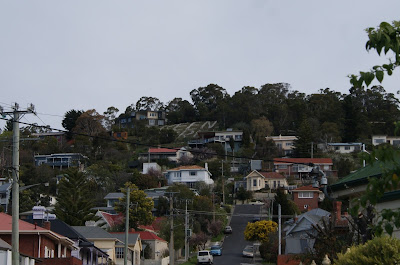The first mention of the Huon area of Tasmania, or Van Diemen's Land, was made in 1788 when Captain Cook landed at Adventure Bay on Bruny Island. Eleven years later, Lieutenant Bligh in the Bounty visited Adventure Bay and planted some apple trees - the beginning of an industry. In 1793 Bruni D'Entrecasteaux visited the area and named Kermandie, Esperance Bay and Recherche Bay after his two ships, D'Entrecasteaux Channel and Port du Cygne (place of swans). In 1802 Commodore Baudin visited Port Cygnet and named the Fleurieu River (later Anges Rivulet). One of his party, Peron, wrote of meeting a beautiful young aboriginal girl - Oura Oura - and her family.

The first settler was William Nichols who sailed around the coast from Browns River (Kingston) where he had a property. He liked the area and in 1834 brought his wife and children to settle along the river valley through which a stream later named Nicholls Rivulet, flowed on toward the bay. Until recent years the remains of the old Nichols house could be seen. It was claimed that Nichols could build his own vessel, rig it and sail it anywhere in the world.

In 1835 the Cowen family came and settled nearby. They were followed by the Bleeze, Poole and Pursell families. In 1838 Matthew Fitzpatrick came from Ireland with his wife and sisters and settled at Petcheys Bay, where he eventually planted an orchard. In 1840 the town at Port Cygnet was divided into building blocks and in 1841 land allotments were for sale at Garden Island Creek. In 1841 William Nichols' daughter married Richard Wilson. Their son, John, was born the following year and became the founder of the boat building firm of John Wilson and Sons. He built vessels in various parts of the bay and for some years located his yards at Martins Point. The gradual silting up of the bay made it necessary to shift his yards to Robleys Point on the opposite side of the bay. Some members of the family still build boats today.

By 1843 there was a thriving community at Port Cygnet. In 1845 Probation Stations for convicts were established at Port Cygnet, Lymington and Nicholls Rivulet and Huon Island. The clearing of land and building of huts continued. There were 333 convicts stationed in the district and a hospital was being built at Lymington where the staff were based. Of the convicts there were blacksmiths, boat crews, brick makers, charcoal and lime burners, carpenters, coopers, carters, gangs for clearing and cultivating, erecting barracks, splitting timber, sawing, fencing timber cutting, rolling logs and hard labour! There were also servants for officers and others and storekeepers. In 1848 the number of convicts began to decline - probably by pardon and ticket of leave.

By 1853 many new settlers were attracted to Port Cygnet, the Probation Stations were gone, streets were named, and in 1862, the town of Lovett was proclaimed. The name of Port Cygnet was retained for the bay. There is confusion as to whether the town was named for the Surveyor General or for one of the early settlers. In 1853 the Hobart Town Advertiser reported of the increasing importance of Port Cygnet. The first District Constable appointed was Edward Chancellor. In 1854, an order was made saying that only free men could be employed in the Police Force. Convicts on Ticket of Leave had been enlisted previously.

Quite a few of the settlers had boats - sailing ketches were used first for transport and these then gave way to steam. Captain Gourlay brought a paddle steamer, the "Culloden" from England in 1853. In 1854 a load of miners arrived on the "Culloden" when gold was discovered on Mt. Mary. Captain Gourlay also had the S.S. Cobra, 46 tons, and obtained a packet licence. This enabled liquor to be served on board. In 1871 it was reported that ketches etc. had lifted 15,120 tons of produce (£43,000) and timber (£12,500), and by 1875, 37 vessels were handling £77,000 of freight per annum. Thomas Nichols, son of William, traded between Hobart and Lovett in "Lady Palmerstone" There were no lights or beacons then and often direction was found by gun shots. In later years still, Reginald Thomas Nichols traded on the river and gave personalized service to all.

At first the only communication, except by water was by bush road to Kingston and then by coach to Hobart Town. The rough track had been made by William Nichols earlier. By now in 1862, roads were being built in the district. By 1872 a money order Post Office was operating and by 1878, the building of a court house was underway. Coal was discovered at Gardners Bay and Mr. Fitzpatrick and Mr. Richard Hill (his father-in-law) had much to do with the development of the mine. In 1882 a Post Office Savings Bank was introduced. Women could bank but had to have the permission of their husbands to draw money out! Military pensioners settled in the district around 1887, many in Slab Road, and by then there was a Post Office, Money Order Office, Electric Telegraph and a Savings Bank.

A new school was erected in 1886 (now the Play Centre). Attendance at school was sometimes low. Once when asked by an Inspector why a certain family, who lived nearby, missed so much school, the teacher replied, "The mother complains of the state of the road in winter". "But I observe that it is no better in the summer", said the inspector. "The father says there are too many snakes about", said the teacher.
The brick State school was erected in 1925 and in 1937 became the first Area school in Southern Tasmania. Children were brought in by bus from all the small schools and enrolment increased to 370 pupils. Subjects ranged from the basic subjects to sewing, cooking, woodwork, blacksmithing, tinsmithing, care of fowls, growing of vegetables aid fruit, apple i.e. picking and pruning etc.
As many as 32 vessels a month passed through the area. There were jetties at Crooked Tree, Deep Bay, Coal Jetty, Herlihys Bay, Petcheys Bay, Wattle Grove, Lymington, Glaziers Bay, and Randalls Bay - these apart from Port Cygnet. All produce had to be carted by dray to these points. In 1895, Mr. Devereaux, owner of the Huon hotel built a hall on the site where the Health Centre is now. This filled a gap in the social life of the town and gatherings there were a plenty. In 1898 the top recreation ground was made.
By this time fruit exports were increasing and shipments to London had already begun. Interstate supplies were increasing also. The fruit season saw most of the towns population working in or about the orchards, while the millers provided the case materials.

Mr. Fitzpatrick imported the first motor car at the turn of the century and later became the first Warden when the Council took office in 1908. Due, probably to confusion caused by the names of "Port Cygnet" and the town of "Lovett", it was decided in 1915 to change the name "Lovett" to "Cygnet". Cygnet became the first district to buy bulk power from the Hydro in 1924. The Court house was completed in 1912 and the Town Hall in 1913. In 1927 a deep water pier at Lymington was suggested - this came about in 1936. In 1932 a second storey was added to the Court house and the buildings of the Town hall and Court house became one. Before the Town Hall and Devereaux's hall were built, the hotels were the meeting places for social and business gatherings.

Today Cygnet is something of a local mecca for artists and creative types in the region, and the local area also has a farming population and there are many second homes (largely owned by Hobart residents). About a mile south of the town centre is a safe anchorage for pleasure craft with easy road access to Cygnet. Cygnet is also the site of the popular annual Cygnet Folk Festival which has developed a reputation as one of the premier cultural events in Tasmania






















































